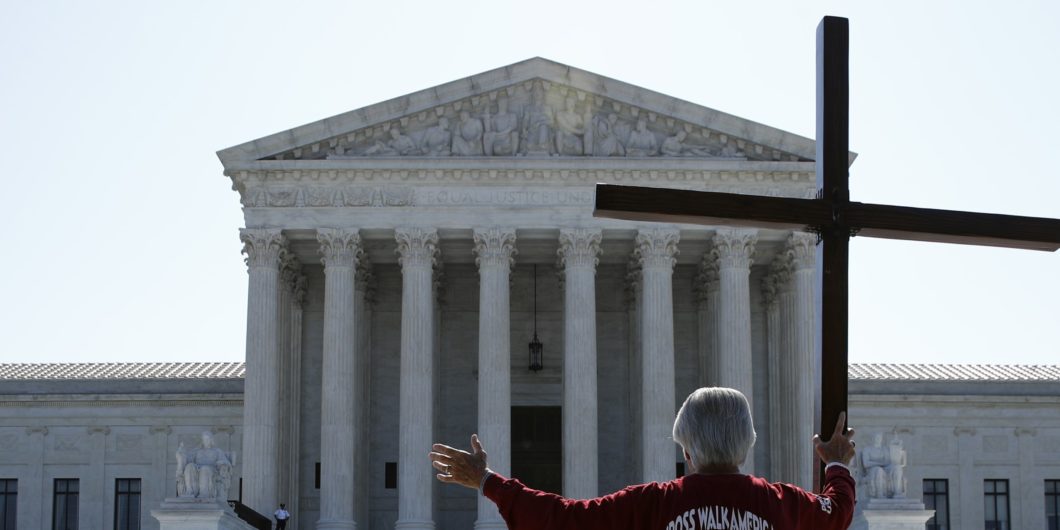Religious Schools and the Freedom of the Church
In a pair of cases involving the religious-freedom rights of parochial schools, the Supreme Court on Wednesday re-affirmed a core First Amendment rule and a crucial aspect of church-state separation, properly understood: Public officials, regulators, and courts lack the authority to decide who should, or should not, perform important religious functions. Questions about religious institutions’ religious teachings, and teachers, belong to the “church” and not to the “state.”
In both cases—Our Lady of Guadalupe School v. Morrissey-Berru and St. James School v. Biel—former parochial-school teachers had filed employment-discrimination lawsuits after they were fired. Neither teacher was a full-time member of the clergy or an officially ordained minister but, as the seven-justice majority emphasized, “both performed vital religious duties” at schools whose mission includes “[e]ducating and forming students in the Catholic faith.” The Court rejected the cramped, mechanistic approach of the courts below, which had focused narrowly on the teachers’ title and training. No “rigid formula” is possible, or necessary, wrote Justice Samuel Alito for the majority. Instead, “[w]hen a school with a religious mission entrusts a teacher with the responsibility of educating and forming students in the faith, judicial intervention into disputes between the school and the teacher threatens the school’s independence in a way that the First Amendment does not allow.” Both as a matter of the schools’ religious liberty and of sensible church-state relations, our constitutional law respects a meaningful sphere of religious autonomy.
The decision, in at least two ways, respects and protects pluralism. For one thing, the Court’s ruling acknowledges the reality that not every domain must or should be governed by the same authority. That is, while employment-discrimination laws play a vitally important role in a variety of contexts and sectors, their reach is and should be limited so that they do not interfere with the adjudication and administration of religious matters. It is—or, at least, it should be—a staple of liberal constitutionalism that powers and authorities are multiplied, divided, checked, and limited. The freedom of religious institutions to decide internal, religious matters for themselves should be seen as an important illustration of this constitutional principle.
In addition, Justice Clarence Thomas, joined by Justice Neil Gorsuch, wrote separately to highlight the importance, especially for “minority faiths” or religious organizations that are “outside the ‘mainstream,’” of deferring to such organizations’ own understandings of religious ministry and leadership. For courts to second-guess these understandings would lead to the kind of church-state entanglements and intrusive official overreach that the First Amendment exists to prevent. And a rule that focused on teachers’ academic credentials, or on religious leaders’ familiar honorific titles, could well work to the disadvantage of religious communities whose practices are less familiar to American judges.
The rulings did not, contrary to the claims of some commentators and media outlets, carve out a new exception from employment laws or invent an alleged license to discriminate. The First Amendment doctrine that the Court reaffirmed and applied has been in place for decades and is rooted in debates that extend back for centuries. It was unanimously confirmed by the justices just eight years ago in the Hosanna-Tabor case. Wednesday’s rulings corrected a lower-court error and vindicated longstanding, fundamental principles. They did not innovate or break new ground. And, importantly, they did not divide the justices sharply along partisan or ideological lines. Justices Elena Kagan and Stephen Breyer joined Justice Alito’s opinion. And, although Justices Ruth Bader Ginsburg and Sonya Sotomayor dissented, endorsing the lower court decisions’ more narrow approach, they did not dispute “that a religious entity’s ability to choose its faith leaders . . . should be free from government interference[.]”
The limits on secular authority are determined not merely by an employee’s title but also, and more importantly, by their role in carrying out the organization’s religious mission.
As the Court had in Hosanna-Tabor, Justice Alito’s opinion emphasized the deeply rooted concern in our law, history, and traditions of “the general principle of church autonomy” and of religious institutions’ “independence in matters of faith and governance and in closely linked matters of internal government.” Along with other scholars, I have explored the connections between the importance of this “general principle” in American constitutional law and some of the great church-state controversies of the past and the long-running (and still continuing) struggle for the “freedom of the church.” As the Court observed, and in keeping with this history, the First Amendment has long been understood as requiring secular authorities to avoid attempting or purporting to “resolv[e] underlying controversies over religious doctrines.” Whatever disagreements might persist about the content of the Constitution’s no-establishment rule (regarding prayers at town-hall meetings or war-memorial crosses, for example), it seems clear that the paradigmatic feature of the kind of religious “establishment” that the First Amendment was designed to rule out is political meddling in the selection of religious ministers, the formulation of religious doctrines, and the teaching of religious truths.
Now, as Justice Thomas noted, the term “ministerial exception is something of a misnomer,” with the potential to distract decision-makers, as it apparently did in the lower courts here. The principle that this doctrine reflects does not apply only to ordained clergy or full-time “ministers.” After all, as Justice Alito stated, “many religious traditions do not use the title ‘minister.’” Instead, the inquiry is a functional one. The limits on secular authority are determined not merely by an employee’s title but also, and more importantly, by his role in carrying out the organization’s religious mission. The issue is not what they are called, but what they do. And because “the religious education and formation of students is the very reason for the existence of most private religious schools, . . . the selection and supervision of the teachers upon whom the schools rely to do this work lie at the core of their mission.”
Going forward, there will be cases that are more difficult than these two. Some school employees’ duties might be obviously unconnected to the schools’ religious missions; the activities of some organizations will be much more distant from religious formation and practice. Still, Wednesday’s ruling was a significant and welcome re-affirmation of a principle that, we should hope, is firmly entrenched in American constitutional law.
A common criticism of, or concern about, the “ministerial exception” doctrine—and, again, we need a new name for this rule—is that, in some cases, it operates to prevent employees who have been treated badly from seeking a legal remedy and insulates from legal oversight a religious employer’s unjust decision. This is true. It is also true, of course, that our Constitution’s rules of criminal procedure sometimes result in guilty offenders not being convicted and that our free-speech guarantee protects expression that is nasty, offensive, foolish, or worse. The premise of the church-autonomy principle is not that religious organizations do not sometimes behave badly. Certainly, they do. And they should be criticized, from within and from without, when they do. But not all wrongs are, or should be, redressable through civil litigation or by secular political power.
One reason why, in some quarters, rulings like Our Lady of Guadalupe School and St. James School come in for criticism is that they can be seen as insulating or excusing, if not justifying, “discrimination.” And, in a culture with our professed egalitarian commitments, the word—indeed, the very idea of—discrimination is, at least at first, jarring and off-putting. It should be remembered, though, that not all “discrimination” is unjust, invidious, or wrongful. All organizations, and all of us, draw distinctions and make decisions on the basis of goal- or mission-oriented criteria, and it is not necessarily wrong to do so.
Others might agree that the religious-freedom principle at issue in these cases matters and should be enforced, but only if the religious organization can prove that the employee in question is undermining or opposing the organization’s religious mission. However, the Court’s opinion wisely reminds us that this is not an inquiry that secular officials should undertake. If a religious institution says that an employee is not carrying out well her religious role, how can a civil official go about deciding that she, in fact, is?
At the end of her dissent, Justice Sotomayor expressed concern about the implications of the decision “in a pluralistic society like ours.” However, it is precisely because ours is a “pluralistic society” that the Court’s 7-2 determination is so important. In a meaningfully pluralistic society, not every organization or institution will act the same way, or be structured in the same way, or have the same goals, or be governed by the same rules. A society without mission-oriented Catholic schools is a less pluralistic society than one with them. A political authority that imposes the same employment rules on every employer, regardless of sector or context or history or aims, is not diverse, but homogenous and monochrome. And, in any event, foundational commitments to limited government and religious liberty require that decisions about religious leaders and teachers be left to religious decisionmakers.



